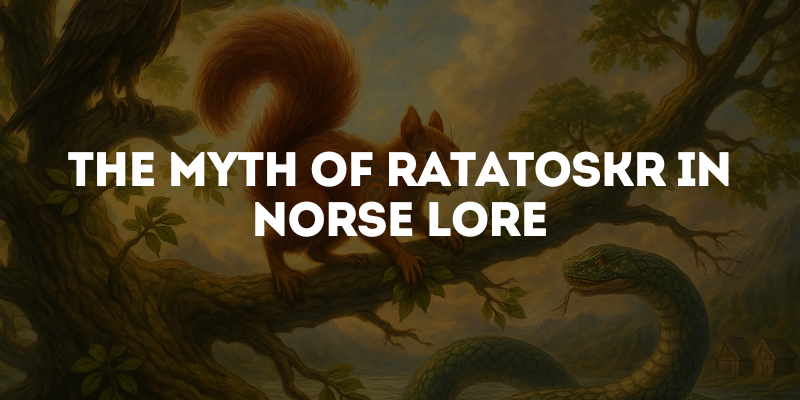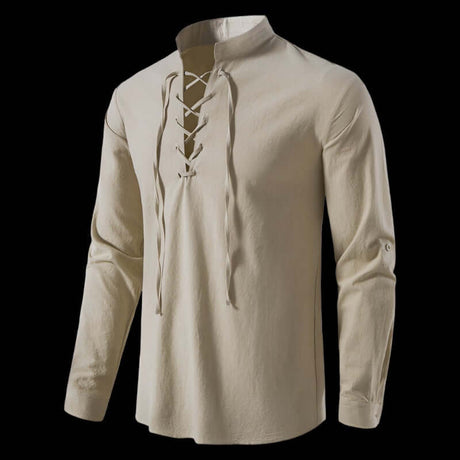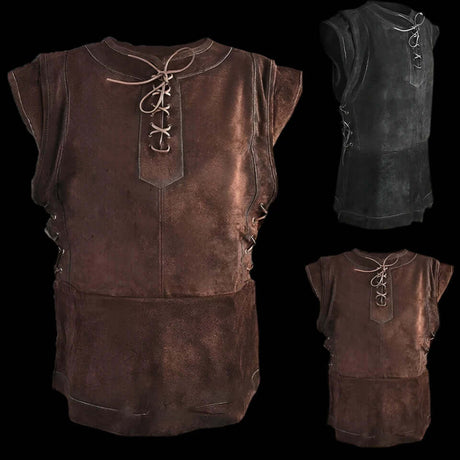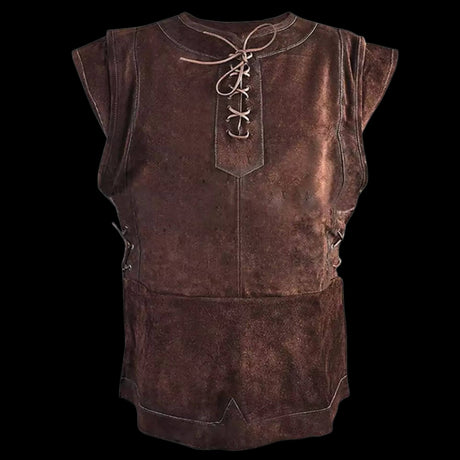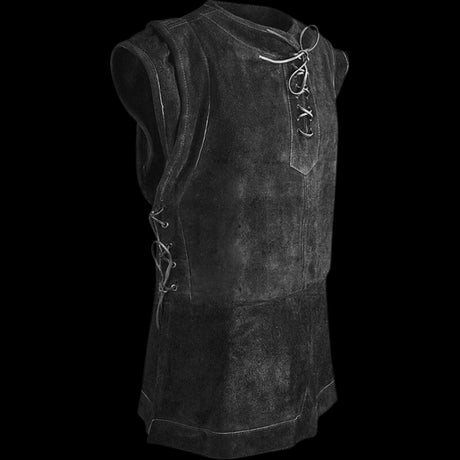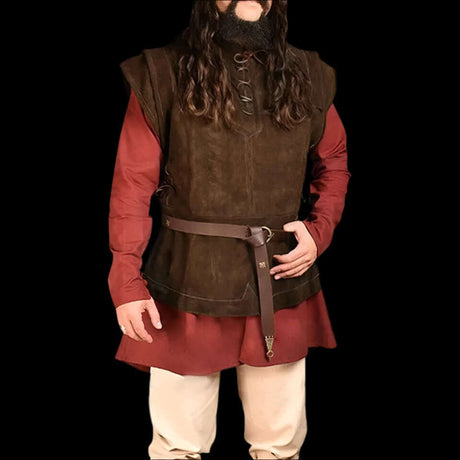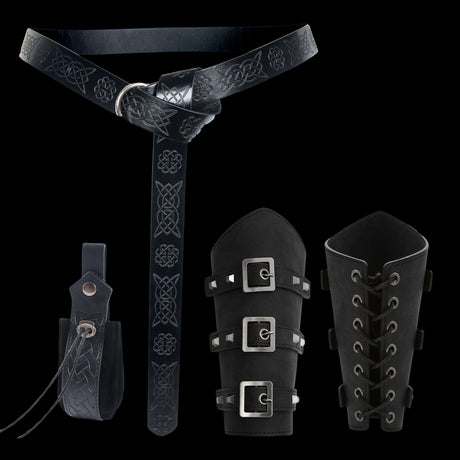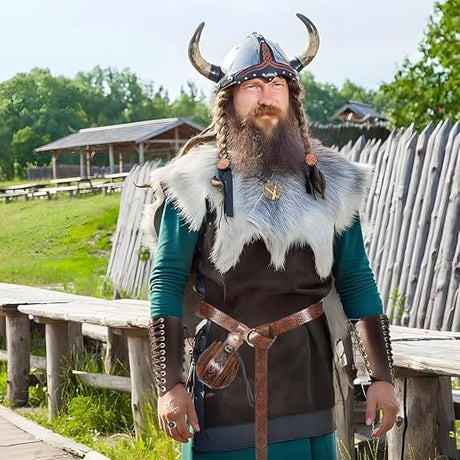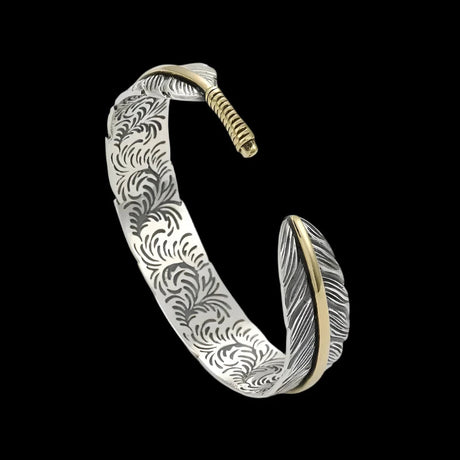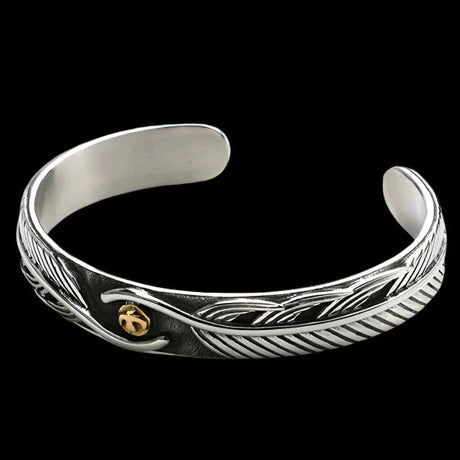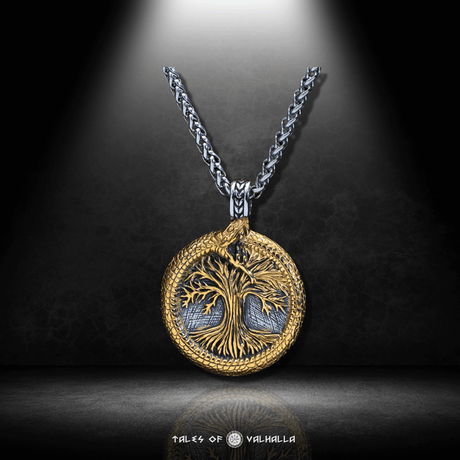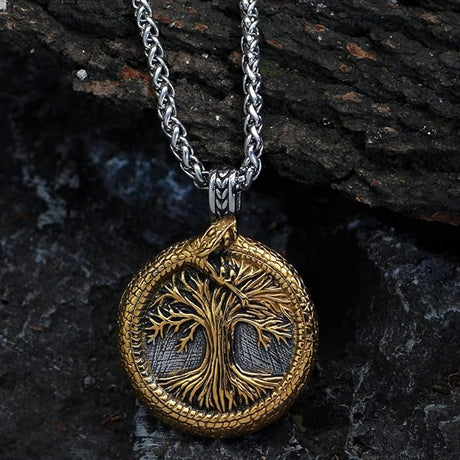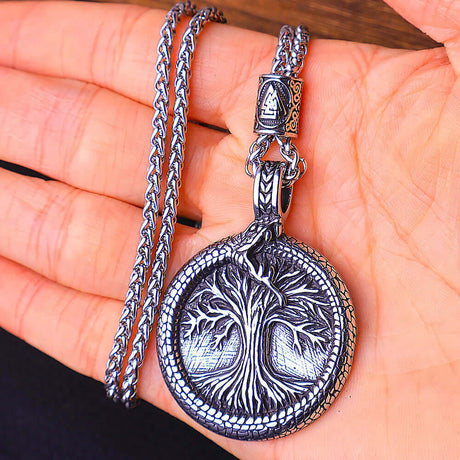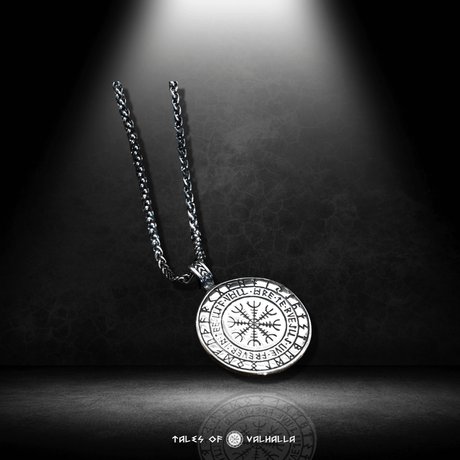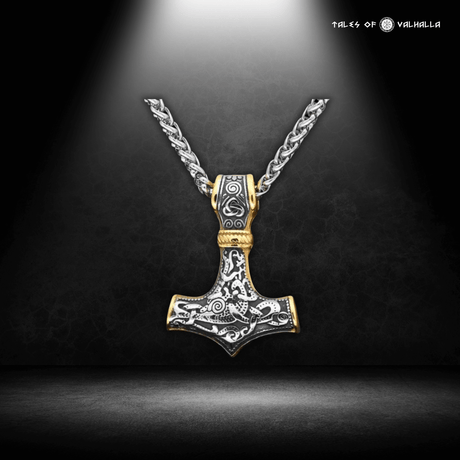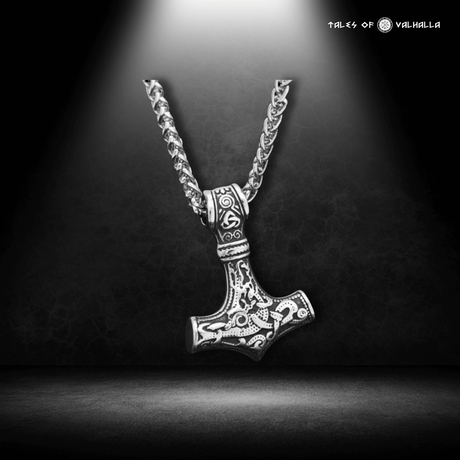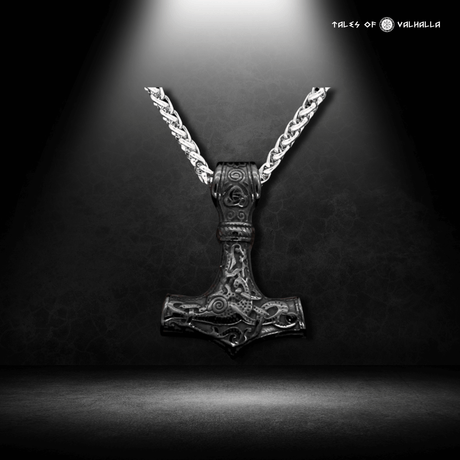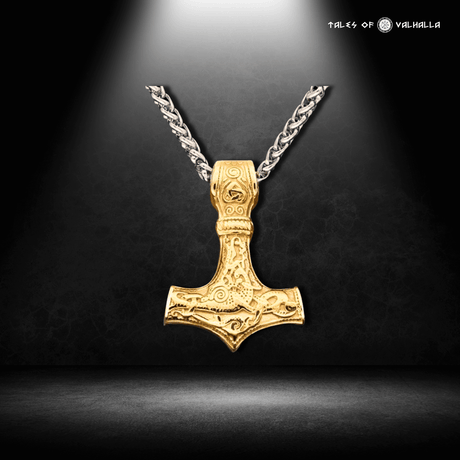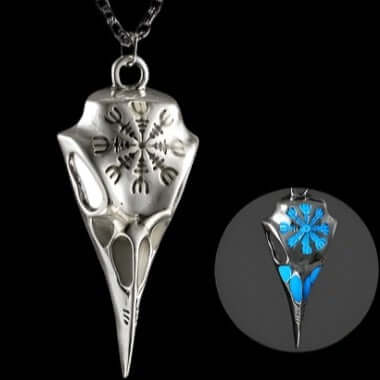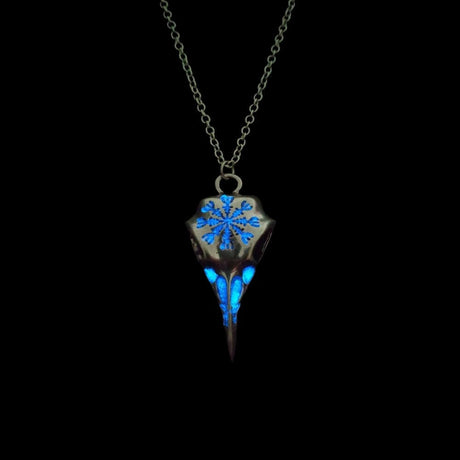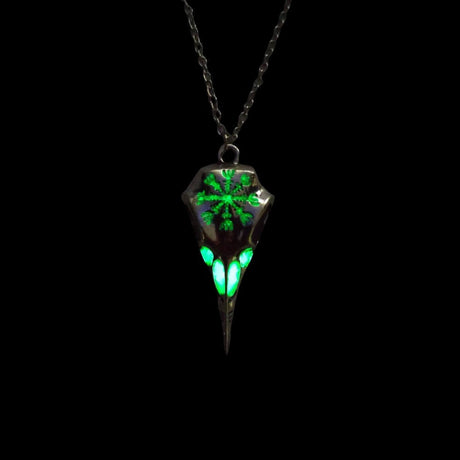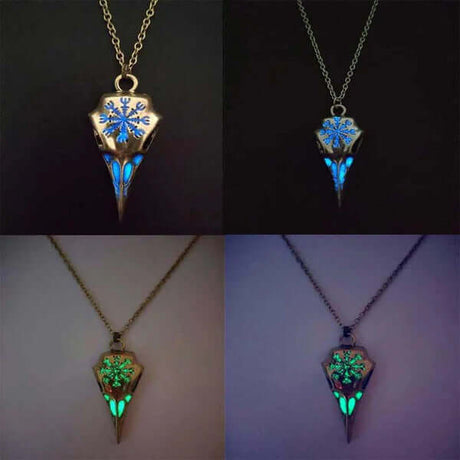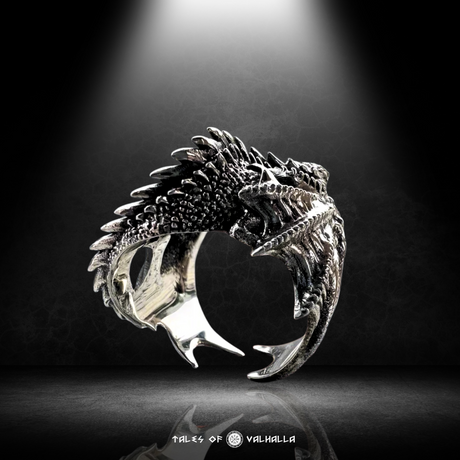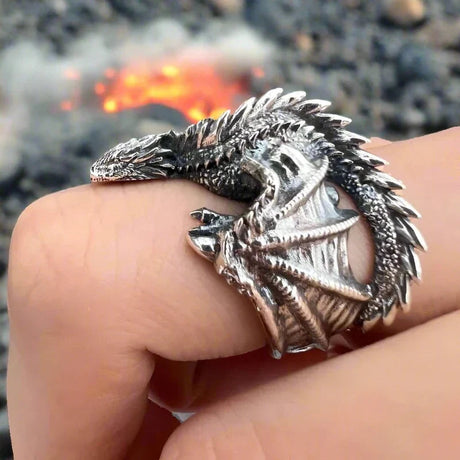Norse mythology paints a vast and often brutal cosmic landscape, dominated by powerful gods like Odin and Thor, fearsome giants, and epic battles foretelling Ragnarök. At the very center of this universe stands Yggdrasil, the immense World Tree connecting the Nine Realms. Amidst the grandeur of gods and the terror of monsters, a seemingly small figure plays a surprisingly persistent role: Ratatoskr, the squirrel who scurries up and down the trunk of Yggdrasil.
But Ratatoskr is no ordinary woodland creature. He is a messenger, a gossip-monger, and perhaps even a deliberate agent of chaos within the Norse cosmos. What is the myth of Ratatoskr in Norse lore? Why a squirrel? And what does this chattering courier tell us about the Viking worldview? This exploration delves deep into the lore surrounding Ratatoskr, examining his role, symbolism, and enduring appeal, separating the whispers of the sagas from modern interpretations.
Who is Ratatoskr? The Squirrel of the World Tree
Despite his unique role and memorable image, Ratatoskr receives relatively brief mentions in the primary sources of Norse mythology. Our main references come from the Poetic Edda and the Prose Edda.
 Ratatoskr? The Squirrel of the World Tree
Ratatoskr? The Squirrel of the World Tree
The Poetic Edda: Grímnismál's Glimpse
In the poem Grímnismál (The Sayings of the Masked One), Odin, disguised as Grímnir, reveals secrets of the cosmos. Among these revelations is a description of the inhabitants of Yggdrasil:
"Ratatoskr is the squirrel named, who has run In the ash-tree Yggdrasil; He from above the eagle's words must carry, And beneath the Nídhöggr repeat." (Translation by Benjamin Thorpe - phrasing may vary slightly in other translations)
This stanza establishes the core function of Ratatoskr: he is a messenger running up and down the World Tree, carrying messages between the unnamed eagle perched at the top and the serpent Níðhöggr gnawing at the roots below.
The Prose Edda: Snorri Sturluson's Confirmation
Snorri Sturluson, in his 13th-century Prose Edda (specifically in the Gylfaginning section), elaborates slightly on Ratatoskr's role:
"An eagle sits at the top of the ash, and it has knowledge of many things. Between its eyes sits the hawk called Vedrfolnir [...]. The squirrel called Ratatoskr 1 runs up and down the ash. He tells slanderous gossip, provoking the eagle and Nidhogg." 2 (Translation by Anthony Faulkes - phrasing may vary slightly)
Snorri adds a crucial detail: the messages Ratatoskr carries are not neutral. They are "slanderous gossip" (róg) intended to provoke animosity between the eagle and Níðhöggr. This casts Ratatoskr in a more mischievous, even malevolent, light. He isn't just delivering mail; he's actively stirring up trouble.
Yggdrasil: The Cosmic Stage for Ratatoskr's Antics
To fully understand Ratatoskr, one must understand his environment: Yggdrasil, the World Tree. This immense ash tree is the axis mundi of Norse cosmology, connecting the Nine Realms and serving as the stage for many cosmic dramas.
The Structure of the Cosmos
Yggdrasil's branches reach into the heavens, sheltering Asgard (realm of the Aesir gods), Vanaheimr (realm of the Vanir gods), and Alfheimr (realm of the light elves). Its trunk passes through Midgard (the realm of humans). Its roots delve deep into the underworld, reaching towards Niflheim (the realm of ice and mist, where Helheim is located) and possibly Jotunheimr (realm of the giants) and Muspelheim (realm of fire).
The Eagle and the Serpent: Cosmic Opposites
At the very top of Yggdrasil sits a great, unnamed eagle, often interpreted as a symbol of wisdom, the heavens, or perhaps even a watchful aspect of Odin. Between its eyes sits the hawk Vedrfolnir. At the very bottom, among the roots, gnaws the monstrous serpent or dragon Níðhöggr, often associated with chaos, destruction, and the dishonorable dead.

The Eagle and the Serpent: Cosmic Opposites
These two creatures represent cosmic opposites – the celestial and the chthonic, the high and the low, perhaps order and chaos. They exist in a state of perpetual antagonism.
Ratatoskr's Domain: The Trunk Between Worlds
It is along the trunk of this cosmic tree, bridging the vast distance between the eagle above and Níðhöggr below, that Ratatoskr makes his endless journey. He is the conduit, the only figure explicitly mentioned as traveling this vertical axis between the opposing forces at the tree's extremities. This unique position makes Ratatoskr a fascinating intermediary.
The Messenger's Role: More Than Just Delivering Mail?
The descriptions in the Eddas paint Ratatoskr not merely as a passive courier but as an active participant in the cosmic drama. His role involves more than simply relaying information; it involves shaping the relationship between the eagle and the serpent.
Facilitator of Conflict: The Cosmic Instigator
Snorri Sturluson explicitly states that Ratatoskr tells "slanderous gossip" designed to "provoke" the eagle and Níðhöggr. This interpretation positions Ratatoskr as a deliberate instigator of conflict.
- Fueling Animosity: By carrying insults, threats, and malicious rumors back and forth, Ratatoskr ensures that the animosity between the eagle and the serpent never fades. He fans the flames of their mutual hatred.
- Agent of Chaos? Is Ratatoskr inherently malevolent, delighting in the discord he creates? Or is his role simply part of the natural order, representing the inherent tension and conflict within the cosmos? Norse mythology often embraces ambiguity, and Ratatoskr fits this mold perfectly. He could be seen as a necessary force, ensuring that stagnation does not set in.
- A Force for Change? Conflict, while destructive, can also be a catalyst for change. Perhaps Ratatoskr's role, by maintaining tension, prevents a static cosmic balance, keeping the universe dynamic, albeit fraught with peril.
Gossip and Slander: The Power of Words in Norse Culture
The emphasis on Ratatoskr carrying slanderous gossip is significant within the context of Viking culture.
- Reputation (Dómr): Reputation and honor were paramount in Viking society. Words held immense power – a person's reputation (dómr) could determine their standing in life and their legacy after death. Slander and insults were serious offenses.
- The Destructive Power of Gossip: Ratatoskr embodies the destructive potential of malicious words. His gossip isn't harmless chatter; it's a corrosive force that maintains hostility between powerful cosmic beings. This reflects a societal understanding of how words could incite feuds and break alliances.
- The Unseen Weapon: While warriors wielded Viking Weapons like axes and swords, Ratatoskr wields words as his weapon, demonstrating that conflict can arise from more subtle, insidious means.
Liminal Figure: Between Worlds, Between Words
Ratatoskr's constant movement up and down Yggdrasil positions him as a liminal figure – a creature existing on the threshold between different realms and states of being.
- Bridging Opposites: He connects the highest point (the eagle in the heavens) with the lowest point (Níðhöggr in the underworld). He traverses the entire known cosmos along the trunk that passes through Midgard.
- Neither God nor Monster: Ratatoskr isn't clearly aligned with either the gods or the monstrous forces. He serves (or perhaps manipulates) both the eagle and the serpent. This ambiguity makes him particularly intriguing.
- Symbol of Communication (and Miscommunication): As a messenger, Ratatoskr represents communication itself. However, given the nature of his messages, he also represents the potential for communication to be distorted, misused, and weaponized.
Why a Squirrel? The Symbolism of the Creature
The choice of a squirrel for this cosmic role is not arbitrary. The characteristics of squirrels lend themselves well to the symbolism associated with Ratatoskr.
Agility, Speed, and Tireless Movement
Squirrels are known for their incredible agility and speed, constantly darting up and down trees.
- The Perfect Messenger: This natural agility makes the squirrel an apt metaphor for a messenger traversing the immense height of the World Tree. Ratatoskr's tireless movement mirrors the constant flow of information (or misinformation) within the cosmos.
- Unpredictability: The quick, sometimes erratic movements of squirrels could also reflect the unpredictable nature of gossip and rumor that Ratatoskr spreads.
Chattering and Perceived Mischief
Squirrels are often perceived as chattering, sometimes intrusive or mischievous creatures.
- The Gossip-Monger: The squirrel's tendency to chatter fits perfectly with Snorri's description of Ratatoskr as a teller of slanderous gossip. His constant noise could be seen as analogous to the spread of rumors.
- Annoyance Factor: Squirrels can sometimes be seen as pests. This perception might align with the potentially disruptive and annoying role Ratatoskr plays in fostering conflict between the eagle and Níðhöggr.
Nature's Intermediary: Between Branches and Roots
Squirrels occupy a middle ground in the forest ecosystem, moving between the high branches and the ground level near the roots.
- Connecting Levels: This mirrors Ratatoskr's role as an intermediary between the celestial eagle and the chthonic serpent. He is perfectly suited to navigate the different levels of the World Tree.
- A Part of the Ecosystem: Just as squirrels are a natural part of the forest ecosystem, Ratatoskr seems to be an inherent part of the cosmic ecosystem of Yggdrasil, fulfilling a specific, albeit potentially troublesome, function.
Ratatoskr in the Wider Context of Norse Mythology
To fully appreciate Ratatoskr, it's helpful to compare him to other figures and themes within Norse mythology.

Ratatoskr in the Wider Context of Norse Mythology
Compared to Other Messengers: Hermod and the Ravens
Norse mythology features other messengers, but Ratatoskr stands apart.
- Hermod: The god Hermod famously journeyed to Helheim to plead for Baldr's return. His mission was specific, noble, and undertaken on behalf of the gods. Ratatoskr, in contrast, seems to operate independently, driven by mischief or perhaps an inherent function, carrying messages of strife rather than pleas for reconciliation.
- Odin's Ravens (Huginn and Muninn): Huginn (Thought) and Muninn (Memory) fly throughout the world gathering information for Odin. They are extensions of Odin's wisdom and perception. Ratatoskr, however, seems to serve his own agenda (or the inherent conflict of the cosmos), spreading discord rather than gathering intelligence for a higher purpose.
The Trickster Element: A Touch of Loki?
Does Ratatoskr share characteristics with trickster figures like Loki?
- Sowing Discord: Like Loki, Ratatoskr seems to thrive on creating chaos and conflict. His slanderous gossip disrupts the (already tense) cosmic order.
- Ambiguous Morality: Neither purely good nor purely evil, Ratatoskr operates in a morally gray area, much like many trickster figures. His motives remain unclear.
- Difference: However, unlike Loki, whose actions often have major, world-altering consequences, Ratatoskr's mischief seems more localized, focused specifically on the relationship between the eagle and the serpent. He is a minor player in the grand scheme, yet his constant activity contributes to the overall tension.
Maintaining Cosmic (Dis)Order?: A Necessary Nuisance?
Could Ratatoskr's seemingly negative role actually be essential to the Norse cosmos?
- The Balance of Opposites: Norse mythology often emphasizes the balance between opposing forces (e.g., fire and ice at creation, Aesir and Vanir). The conflict between the eagle and Níðhöggr represents a fundamental cosmic tension.
- Preventing Stagnation: Perhaps Ratatoskr's role is to ensure this tension never fully resolves, preventing cosmic stagnation. His constant stirring of the pot keeps the universe dynamic, even if that dynamism involves conflict. He represents the ongoing struggle inherent in existence.
- A Reflection of Reality: The myth of Ratatoskr might reflect the Viking understanding of the world – a place where conflict, gossip, and misunderstanding are constant and perhaps even necessary parts of life.
Interpreting Ratatoskr: Scholarly Views and Modern Takes
Given the limited source material, interpretations of Ratatoskr vary among scholars and modern enthusiasts.
- Symbol of Communication Breakdown: Some see Ratatoskr as a symbol of how communication can fail, how messages can be distorted, and how words can be used to sow discord.
- Representation of Natural Forces: Others interpret him more literally as simply part of the fauna inhabiting the World Tree, his actions reflecting the natural behaviors of a squirrel within its ecosystem.
- Psychological Archetype: In a Jungian sense, Ratatoskr could represent the mischievous, rumour-spreading aspect of the human psyche, the part that delights in gossip and stirring up trouble.
- Minor but Memorable: Despite his brief appearances, Ratatoskr's unique role and vivid imagery make him a memorable figure, sparking ongoing discussion and interpretation.
Ratatoskr's Enduring Appeal: From Eddas to Pop Culture
Despite being a relatively minor figure in the grand tapestry of Norse mythology, Ratatoskr continues to capture the imagination and appear in various forms of modern culture.
- Video Games: Ratatoskr has appeared in numerous video games inspired by Norse mythology, such as God of War (2018 and Ragnarök), Assassin's Creed Valhalla, and Smite. Game developers often expand on his character, sometimes giving him a more significant role or personality.
- Literature: Modern fantasy authors sometimes incorporate Ratatoskr into their works, playing on his role as a messenger or trickster.
- Art and Illustration: The image of the squirrel scurrying up Yggdrasil is a popular subject for artists interested in Norse mythology, allowing for creative interpretations of his appearance and character.
- Merchandise: You can find Ratatoskr featured on t-shirts, jewelry, and other merchandise aimed at fans of Viking culture.
Table: Ratatoskr in Modern Media
This table highlights the continued presence of Ratatoskr in modern interpretations, demonstrating his enduring appeal despite his limited appearances in the original myths.
Conclusion
Ratatoskr, the squirrel messenger of Yggdrasil, may seem like a footnote in the grand narrative of Norse mythology. Yet, his persistent scurrying between the eagle at the top and the serpent at the roots carries significant weight. He embodies the power of communication – and miscommunication. He represents the inherent conflict and tension within the cosmos, perhaps even serving as a necessary catalyst, preventing stagnation through his mischievous gossip-mongering.
Ratatoskr reminds us that even seemingly minor figures can play crucial roles and that the Norse worldview was filled with complex, ambiguous characters who defy easy categorization. His myth encourages us to look closer, to appreciate the intricate details of the Norse cosmos, and to recognize the power that even the smallest voice (or chattering squirrel) can wield. The enduring fascination with Ratatoskr speaks volumes about our own relationship with communication, conflict, and the intricate web of connections that define our world.
FAQs
-
Who is Ratatoskr in Norse mythology?
Ratatoskr is a squirrel who lives on the World Tree, Yggdrasil. His primary role is described as a messenger, constantly running up and down the trunk.
-
What does Ratatoskr do on Yggdrasil?
According to the Eddas, Ratatoskr carries messages, specifically described as "slanderous gossip" by Snorri Sturluson, between the unnamed eagle perched at the top of Yggdrasil and the serpent Níðhöggr gnawing at its roots. His actions actively provoke conflict between these two figures.
-
Is Ratatoskr considered an evil figure?
Not necessarily evil, but certainly mischievous and disruptive. He thrives on spreading insults and fostering animosity. Some interpretations see Ratatoskr as representing the destructive power of gossip or even a necessary agent of chaos maintaining cosmic tension, rather than being purely malevolent.
-
Why is Ratatoskr depicted as a squirrel?
The choice of a squirrel likely relates to its natural characteristics. Squirrels are known for their agility and speed in climbing trees, fitting for a messenger on the vast Yggdrasil. Their chattering nature also aligns well with the description of Ratatoskr as a gossip-monger.
-
Where is Ratatoskr mentioned in the original Norse texts?
Ratatoskr receives brief mentions in two key sources: the Poetic Edda (specifically in the poem Grímnismál) and Snorri Sturluson's Prose Edda (in the Gylfaginning section). These mentions establish his role but leave much open to interpretation.
-
Does Ratatoskr appear in modern popular culture?
Yes, despite his minor role in the original myths, Ratatoskr has gained popularity and appears in various modern interpretations, including video games like God of War and Assassin's Creed Valhalla, as well as in literature and art inspired by Norse mythology.

